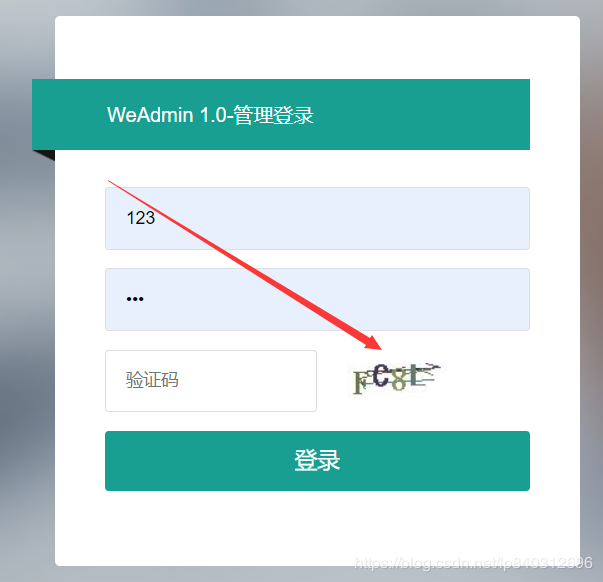今天記錄一下驗證碼的實現,希望能夠幫助到大家! 首先我們看一下實現的效果: 此驗證碼的實現沒有用到太多的插件,話不多說直接上代碼,大家拿過去就可以用。 中間用到了org.apache.commons.lang3.RandomUtils工具類,需要pom配置: <!-- https://mvnrepo ...
今天記錄一下驗證碼的實現,希望能夠幫助到大家!
首先我們看一下實現的效果:

此驗證碼的實現沒有用到太多的插件,話不多說直接上代碼,大家拿過去就可以用。
中間用到了org.apache.commons.lang3.RandomUtils工具類,需要pom配置:
<!-- https://mvnrepository.com/artifact/org.apache.commons/commons-lang3 --> <dependency> <groupId>org.apache.commons</groupId> <artifactId>commons-lang3</artifactId> <version>3.10</version> </dependency>
1.驗證碼類
package com.youyou.login.util.validatecode; import lombok.Data; /** * 驗證碼類 */ public class VerifyCode { private String code; private byte[] imgBytes; private long expireTime; public String getCode() { return code; } public void setCode(String code) { this.code = code; } public byte[] getImgBytes() { return imgBytes; } public void setImgBytes(byte[] imgBytes) { this.imgBytes = imgBytes; } public long getExpireTime() { return expireTime; } public void setExpireTime(long expireTime) { this.expireTime = expireTime; } }
2.驗證碼生成介面
package com.youyou.login.util.validatecode; import java.io.IOException; import java.io.OutputStream; /** * 驗證碼生成介面 */ public interface IVerifyCodeGen { /** * 生成驗證碼並返回code,將圖片寫的os中 * * @param width * @param height * @param os * @return * @throws IOException */ String generate(int width, int height, OutputStream os) throws IOException; /** * 生成驗證碼對象 * * @param width * @param height * @return * @throws IOException */ VerifyCode generate(int width, int height) throws IOException; }
3.驗證碼生成實現類
package com.youyou.login.util.validatecode; import com.youyou.util.RandomUtils; import org.slf4j.Logger; import org.slf4j.LoggerFactory; import javax.imageio.ImageIO; import java.awt.*; import java.awt.image.BufferedImage; import java.io.ByteArrayOutputStream; import java.io.IOException; import java.io.OutputStream; import java.util.Random; /** * 驗證碼實現類 */ public class SimpleCharVerifyCodeGenImpl implements IVerifyCodeGen { private static final Logger logger = LoggerFactory.getLogger(SimpleCharVerifyCodeGenImpl.class); private static final String[] FONT_TYPES = { "\u5b8b\u4f53", "\u65b0\u5b8b\u4f53", "\u9ed1\u4f53", "\u6977\u4f53", "\u96b6\u4e66" }; private static final int VALICATE_CODE_LENGTH = 4; /** * 設置背景顏色及大小,干擾線 * * @param graphics * @param width * @param height */ private static void fillBackground(Graphics graphics, int width, int height) { // 填充背景 graphics.setColor(Color.WHITE); //設置矩形坐標x y 為0 graphics.fillRect(0, 0, width, height); // 加入干擾線條 for (int i = 0; i < 8; i++) { //設置隨機顏色演算法參數 graphics.setColor(RandomUtils.randomColor(40, 150)); Random random = new Random(); int x = random.nextInt(width); int y = random.nextInt(height); int x1 = random.nextInt(width); int y1 = random.nextInt(height); graphics.drawLine(x, y, x1, y1); } } /** * 生成隨機字元 * * @param width * @param height * @param os * @return * @throws IOException */ @Override public String generate(int width, int height, OutputStream os) throws IOException { BufferedImage image = new BufferedImage(width, height, BufferedImage.TYPE_INT_RGB); Graphics graphics = image.getGraphics(); fillBackground(graphics, width, height); String randomStr = RandomUtils.randomString(VALICATE_CODE_LENGTH); createCharacter(graphics, randomStr); graphics.dispose(); //設置JPEG格式 ImageIO.write(image, "JPEG", os); return randomStr; } /** * 驗證碼生成 * * @param width * @param height * @return */ @Override public VerifyCode generate(int width, int height) { VerifyCode verifyCode = null; try ( //將流的初始化放到這裡就不需要手動關閉流 ByteArrayOutputStream baos = new ByteArrayOutputStream(); ) { String code = generate(width, height, baos); verifyCode = new VerifyCode(); verifyCode.setCode(code); verifyCode.setImgBytes(baos.toByteArray()); } catch (IOException e) { logger.error(e.getMessage(), e); verifyCode = null; } return verifyCode; } /** * 設置字元顏色大小 * * @param g * @param randomStr */ private void createCharacter(Graphics g, String randomStr) { char[] charArray = randomStr.toCharArray(); for (int i = 0; i < charArray.length; i++) { //設置RGB顏色演算法參數 g.setColor(new Color(50 + RandomUtils.nextInt(100), 50 + RandomUtils.nextInt(100), 50 + RandomUtils.nextInt(100))); //設置字體大小,類型 g.setFont(new Font(FONT_TYPES[RandomUtils.nextInt(FONT_TYPES.length)], Font.BOLD, 26)); //設置x y 坐標 g.drawString(String.valueOf(charArray[i]), 15 * i + 5, 19 + RandomUtils.nextInt(8)); } } }
4.工具類
package com.youyou.util; import java.awt.*; import java.util.Random; public class RandomUtils extends org.apache.commons.lang3.RandomUtils { private static final char[] CODE_SEQ = { 'A', 'B', 'C', 'D', 'E', 'F', 'G', 'H', 'J', 'K', 'L', 'M', 'N', 'P', 'Q', 'R', 'S', 'T', 'U', 'V', 'W', 'X', 'Y', 'Z', '2', '3', '4', '5', '6', '7', '8', '9' }; private static final char[] NUMBER_ARRAY = { '0', '1', '2', '3', '4', '5', '6', '7', '8', '9' }; private static Random random = new Random(); public static String randomString(int length) { StringBuilder sb = new StringBuilder(); for (int i = 0; i < length; i++) { sb.append(String.valueOf(CODE_SEQ[random.nextInt(CODE_SEQ.length)])); } return sb.toString(); } public static String randomNumberString(int length) { StringBuilder sb = new StringBuilder(); for (int i = 0; i < length; i++) { sb.append(String.valueOf(NUMBER_ARRAY[random.nextInt(NUMBER_ARRAY.length)])); } return sb.toString(); } public static Color randomColor(int fc, int bc) { int f = fc; int b = bc; Random random = new Random(); if (f > 255) { f = 255; } if (b > 255) { b = 255; } return new Color(f + random.nextInt(b - f), f + random.nextInt(b - f), f + random.nextInt(b - f)); } public static int nextInt(int bound) { return random.nextInt(bound); } }
經過以上代碼,我們的驗證碼生成功能基本上已經實現了,現在還需要一個controller來調用它。
@ApiOperation(value = "驗證碼") @GetMapping("/verifyCode") public void verifyCode(HttpServletRequest request, HttpServletResponse response) { IVerifyCodeGen iVerifyCodeGen = new SimpleCharVerifyCodeGenImpl(); try { //設置長寬 VerifyCode verifyCode = iVerifyCodeGen.generate(80, 28); String code = verifyCode.getCode(); LOGGER.info(code); //將VerifyCode綁定session request.getSession().setAttribute("VerifyCode", code); //設置響應頭 response.setHeader("Pragma", "no-cache"); //設置響應頭 response.setHeader("Cache-Control", "no-cache"); //在代理伺服器端防止緩衝 response.setDateHeader("Expires", 0); //設置響應內容類型 response.setContentType("image/jpeg"); response.getOutputStream().write(verifyCode.getImgBytes()); response.getOutputStream().flush(); } catch (IOException e) { LOGGER.info("", e); } }
搞定!後臺編寫到此結束了。那麼又會有博友說了:“說好的實現效果呢?”
好吧,那麼我們繼續前端的代碼編寫。
前端代碼:
<html> <body> <div> <input id="code" placeholder="驗證碼" type="text" class="" style="width:170px"> <!-- 驗證碼 顯示 --> <img οnclick="javascript:getvCode()" id="verifyimg" style="margin-left: 20px;"/> </div> <script type="text/javascript"> getvCode(); /** * 獲取驗證碼 * 將驗證碼寫到login.html頁面的id = verifyimg 的地方 */ function getvCode() { document.getElementById("verifyimg").src = timestamp("http://127.0.0.1:81/verifyCode"); } //為url添加時間戳 function timestamp(url) { var getTimestamp = new Date().getTime(); if (url.indexOf("?") > -1) { url = url + "×tamp=" + getTimestamp } else { url = url + "?timestamp=" + getTimestamp } return url; }; </script> </body> </html>
可以實現點擊圖片更換驗證碼。
實現效果:

當然文章開頭的截圖是我系統中的截圖,需要大家自己去根據自己的情況去開發前端了。
原文鏈接:https://blog.csdn.net/qq_37651267/article/details/99305573



